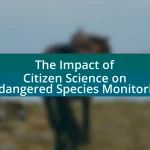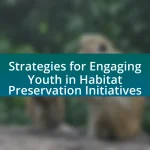Engaging Indigenous Knowledge in Conservation Efforts focuses on the integration of traditional ecological knowledge from Indigenous peoples into modern conservation strategies. This approach highlights the effectiveness of Indigenous practices in enhancing biodiversity and ecosystem resilience, often resulting in better conservation outcomes compared to conventional methods. The article discusses the principles of Indigenous knowledge, the differences between Indigenous and Western scientific approaches, and the importance of collaboration with Indigenous communities. It also addresses the challenges and barriers to integrating Indigenous knowledge into conservation efforts, while providing examples of successful case studies and practical applications. Additionally, it emphasizes the role of education and policy changes in promoting Indigenous knowledge within conservation frameworks.
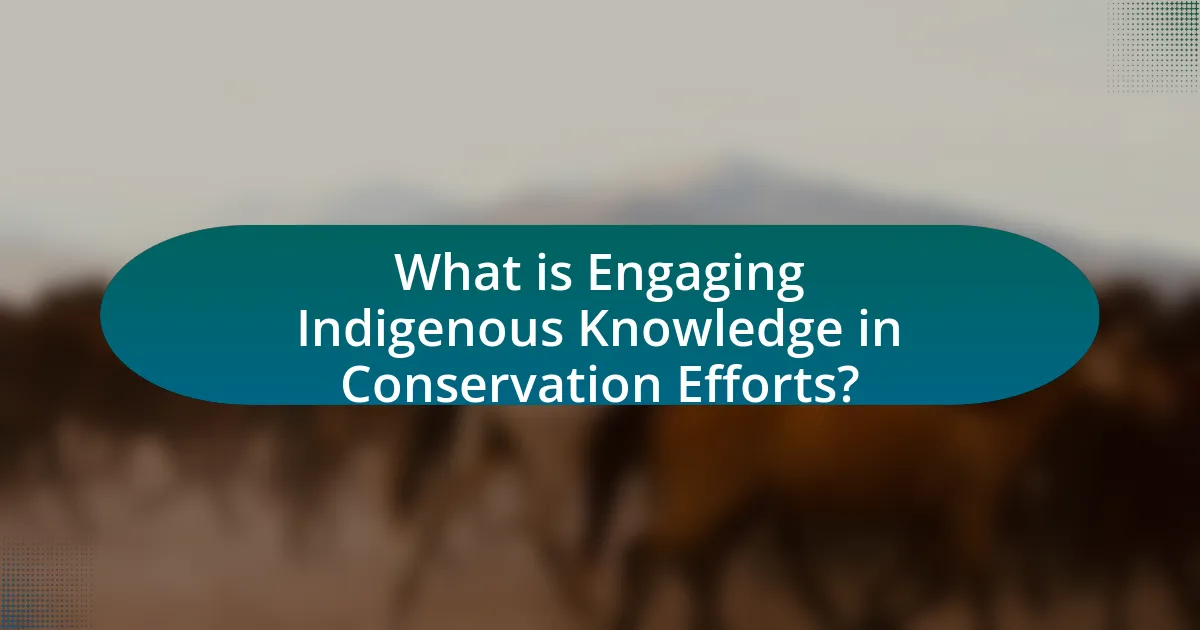
What is Engaging Indigenous Knowledge in Conservation Efforts?
Engaging Indigenous Knowledge in Conservation Efforts involves integrating traditional ecological knowledge and practices of Indigenous peoples into contemporary conservation strategies. This approach recognizes the deep understanding Indigenous communities have of their local ecosystems, which has been developed over generations. For instance, studies have shown that Indigenous-managed lands often exhibit higher biodiversity and resilience compared to conventionally managed areas, highlighting the effectiveness of their practices in maintaining ecological balance. By collaborating with Indigenous communities, conservation efforts can benefit from their unique insights, leading to more sustainable and culturally relevant outcomes.
How does Indigenous knowledge contribute to conservation practices?
Indigenous knowledge contributes to conservation practices by providing a deep understanding of local ecosystems and sustainable resource management. This knowledge, developed over generations, includes traditional ecological practices that enhance biodiversity and ecosystem resilience. For example, Indigenous fire management techniques, such as controlled burns, have been shown to reduce wildfire risks and promote healthy landscapes, as evidenced by studies indicating that areas managed with Indigenous practices often exhibit greater biodiversity compared to those managed solely by modern methods. Additionally, Indigenous communities often possess unique insights into species behavior and habitat needs, which can inform conservation strategies and improve outcomes for endangered species.
What are the key principles of Indigenous knowledge in environmental stewardship?
The key principles of Indigenous knowledge in environmental stewardship include a deep connection to the land, holistic understanding of ecosystems, and the importance of community involvement. Indigenous peoples view the land as a living entity, fostering a relationship that emphasizes respect and reciprocity. This perspective leads to sustainable practices that are informed by generations of observation and experience, ensuring the health of ecosystems. Furthermore, community involvement is crucial, as stewardship is often a collective responsibility, integrating traditional ecological knowledge with contemporary conservation efforts. These principles are validated by numerous studies, such as the research conducted by Berkes et al. (2000), which highlights the effectiveness of Indigenous practices in biodiversity conservation and ecosystem management.
How does Indigenous knowledge differ from Western scientific approaches?
Indigenous knowledge differs from Western scientific approaches primarily in its holistic and experiential nature. Indigenous knowledge is rooted in the cultural, spiritual, and historical contexts of specific communities, emphasizing relationships with the land and ecosystems over time. In contrast, Western scientific approaches often prioritize empirical data, experimentation, and objective analysis, focusing on isolating variables and reproducibility.
For example, Indigenous peoples have utilized traditional ecological knowledge for thousands of years, which includes practices like controlled burns to manage landscapes, a method supported by studies showing its effectiveness in promoting biodiversity and preventing larger wildfires. This contrasts with Western science, which may take a more fragmented view of ecosystems, often relying on quantitative data without the same depth of contextual understanding.
Why is it important to engage Indigenous communities in conservation?
Engaging Indigenous communities in conservation is crucial because they possess unique ecological knowledge and a deep connection to their ancestral lands. This knowledge, often accumulated over generations, includes sustainable practices that have proven effective in managing local ecosystems. For instance, studies have shown that Indigenous-managed lands often exhibit higher biodiversity and resilience compared to areas without such management. Furthermore, involving Indigenous communities fosters collaboration, ensuring that conservation efforts are culturally relevant and more likely to succeed. This approach aligns with the principles of co-management, which have been recognized in various international agreements, such as the United Nations Declaration on the Rights of Indigenous Peoples, emphasizing the importance of Indigenous participation in environmental governance.
What benefits arise from collaboration between Indigenous peoples and conservationists?
Collaboration between Indigenous peoples and conservationists leads to enhanced biodiversity conservation and sustainable resource management. Indigenous peoples possess traditional ecological knowledge that has been developed over generations, which can inform conservation strategies and practices. For instance, studies have shown that areas managed by Indigenous communities often exhibit higher levels of biodiversity compared to those managed by non-Indigenous entities. This is evidenced by research published in the journal “Nature” (2020) by authors including David J. G. Slade, which highlights that Indigenous-led conservation initiatives can effectively protect ecosystems while respecting cultural values. Additionally, such collaborations can foster community resilience and improve the livelihoods of Indigenous peoples, as they gain recognition and support for their stewardship roles in conservation efforts.
How does engaging Indigenous knowledge enhance biodiversity conservation?
Engaging Indigenous knowledge enhances biodiversity conservation by integrating traditional ecological practices that have been developed over generations. Indigenous communities possess a deep understanding of local ecosystems, species interactions, and sustainable resource management, which can inform conservation strategies. For instance, studies have shown that Indigenous-managed lands often exhibit higher biodiversity levels compared to areas under conventional management, as seen in the work by the United Nations Environment Programme, which highlights the effectiveness of Indigenous stewardship in preserving habitats and species. This knowledge not only contributes to more effective conservation outcomes but also fosters resilience against environmental changes, thereby supporting overall ecosystem health.
What challenges exist in integrating Indigenous knowledge into conservation efforts?
Integrating Indigenous knowledge into conservation efforts faces several challenges, primarily stemming from differing worldviews and communication barriers. Indigenous knowledge systems often emphasize holistic and relational understandings of ecosystems, which can conflict with Western scientific approaches that prioritize quantitative data and individual species management. Additionally, there is often a lack of recognition and respect for Indigenous rights and sovereignty, leading to mistrust between Indigenous communities and conservation organizations. This mistrust can hinder collaboration and the sharing of knowledge. Furthermore, institutional frameworks may not adequately accommodate or integrate Indigenous perspectives, resulting in policies that overlook traditional ecological practices. These challenges highlight the need for inclusive approaches that respect and incorporate Indigenous knowledge in meaningful ways.
What are the barriers to effective collaboration with Indigenous communities?
Barriers to effective collaboration with Indigenous communities include historical mistrust, differing worldviews, and inadequate representation in decision-making processes. Historical mistrust stems from past injustices, such as colonization and broken treaties, which have led to skepticism towards external entities. Differing worldviews often result in conflicts over land use and resource management, as Indigenous perspectives prioritize holistic and sustainable practices, while external stakeholders may focus on economic gains. Additionally, inadequate representation in decision-making processes limits Indigenous voices, preventing their knowledge and rights from being fully acknowledged and integrated into conservation efforts. These barriers hinder meaningful partnerships and the successful incorporation of Indigenous knowledge in conservation initiatives.
How can misunderstandings between cultures impact conservation initiatives?
Misunderstandings between cultures can significantly hinder conservation initiatives by creating conflicts over land use, resource management, and differing values regarding nature. For instance, when conservation organizations impose Western conservation models without understanding Indigenous perspectives, it can lead to resistance from local communities, as seen in various case studies where Indigenous land rights were overlooked, resulting in protests and project failures. Research indicates that successful conservation efforts often require integrating Indigenous knowledge, which emphasizes a holistic relationship with the environment, as demonstrated in the work of Berkes et al. (2000) in “Rediscovery of Traditional Ecological Knowledge.” This integration fosters collaboration and enhances the effectiveness of conservation strategies, highlighting the necessity of cultural understanding in achieving conservation goals.
How can we effectively engage Indigenous knowledge in conservation efforts?
Effectively engaging Indigenous knowledge in conservation efforts requires the inclusion of Indigenous communities in decision-making processes and the recognition of their traditional ecological knowledge. Research indicates that Indigenous peoples possess a deep understanding of local ecosystems, which can enhance biodiversity conservation strategies. For instance, a study published in the journal “Nature” by Davis and Slobodkin (2020) highlights how Indigenous land management practices, such as controlled burns, have been shown to improve habitat health and reduce wildfire risks. By collaborating with Indigenous communities, conservation initiatives can leverage this knowledge to create more effective and culturally relevant conservation strategies.
What strategies can be employed to foster collaboration with Indigenous communities?
To foster collaboration with Indigenous communities, it is essential to establish mutual respect and trust through open communication and active listening. Engaging Indigenous leaders and community members in the decision-making process ensures that their knowledge and perspectives are valued, which is crucial for effective collaboration. For instance, the United Nations Declaration on the Rights of Indigenous Peoples emphasizes the importance of free, prior, and informed consent in projects affecting Indigenous lands and resources, highlighting the need for genuine partnership. Additionally, incorporating Indigenous knowledge systems into conservation efforts can enhance ecological outcomes, as demonstrated by various case studies where traditional ecological knowledge has led to more sustainable practices.
How can conservation organizations build trust with Indigenous peoples?
Conservation organizations can build trust with Indigenous peoples by actively involving them in decision-making processes regarding land and resource management. This approach acknowledges Indigenous rights and knowledge systems, fostering a collaborative relationship. For instance, the United Nations Declaration on the Rights of Indigenous Peoples emphasizes the importance of free, prior, and informed consent, which reinforces the need for conservation organizations to engage Indigenous communities in meaningful dialogue. Studies have shown that when Indigenous peoples are included in conservation efforts, such as the case of the Ainu in Japan, the outcomes are more sustainable and culturally relevant, demonstrating the effectiveness of trust-building through collaboration.
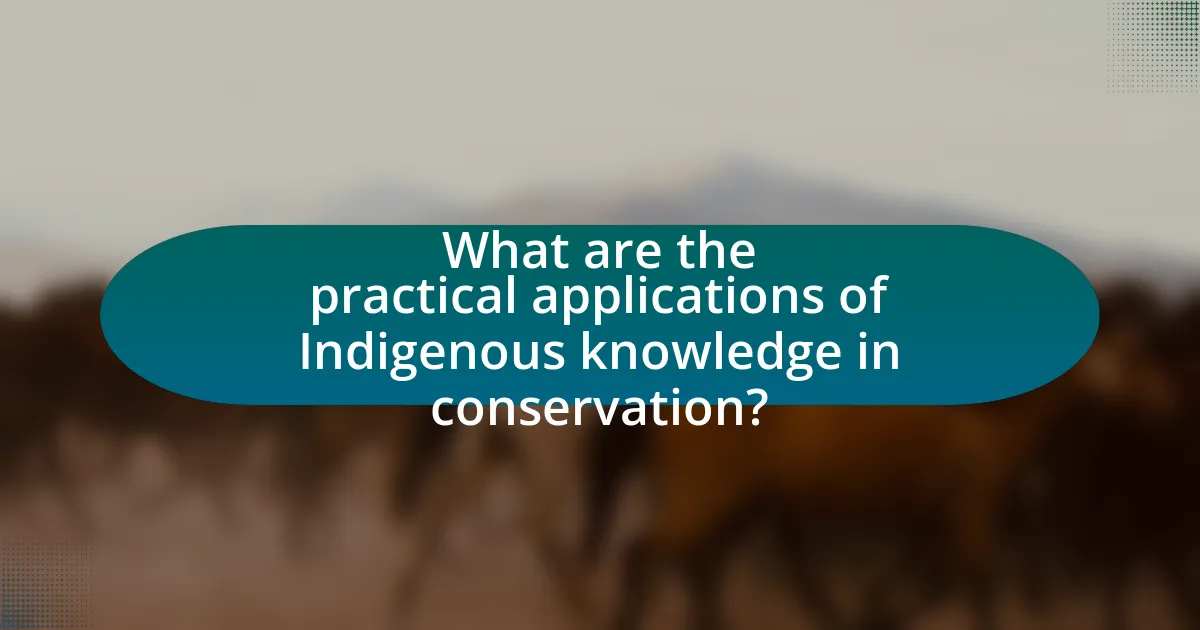
What are the practical applications of Indigenous knowledge in conservation?
Indigenous knowledge has practical applications in conservation through sustainable land management practices, biodiversity preservation, and ecosystem restoration. For instance, Indigenous communities often utilize traditional ecological knowledge to manage resources sustainably, which has been shown to enhance biodiversity. A study published in the journal “Nature” by David J. K. McGregor et al. (2018) highlights how Indigenous fire management techniques can reduce wildfire risks and promote healthy ecosystems. Additionally, Indigenous practices in fisheries management, such as seasonal fishing restrictions, have been effective in maintaining fish populations and promoting ecological balance. These applications demonstrate the value of integrating Indigenous knowledge into contemporary conservation strategies for improved environmental outcomes.
How is Indigenous knowledge applied in specific conservation projects?
Indigenous knowledge is applied in specific conservation projects through the integration of traditional ecological knowledge (TEK) into biodiversity management and land stewardship practices. For instance, in the Great Bear Rainforest in British Columbia, Indigenous communities collaborated with environmental organizations to develop conservation strategies that respect traditional land use and ecological practices, leading to the protection of over 2.1 million acres of forest. This collaboration not only enhances biodiversity but also incorporates Indigenous perspectives on sustainable resource management, demonstrating the effectiveness of combining scientific and Indigenous knowledge for conservation outcomes.
What successful case studies demonstrate the effectiveness of Indigenous knowledge?
Successful case studies demonstrating the effectiveness of Indigenous knowledge include the collaborative management of the Great Bear Rainforest in British Columbia, Canada, and the use of traditional ecological knowledge (TEK) in the restoration of the Kanyini landscape in Australia. In the Great Bear Rainforest, Indigenous communities partnered with environmental organizations to protect the ecosystem, integrating traditional practices with modern conservation strategies, which resulted in the preservation of biodiversity and sustainable resource management. In Australia, the Kanyini project utilized TEK to restore land and water health, leading to improved ecological outcomes and community well-being, as evidenced by increased native species populations and enhanced cultural practices. These examples illustrate how Indigenous knowledge can effectively contribute to conservation efforts by combining traditional wisdom with contemporary environmental science.
How can traditional ecological knowledge inform modern conservation strategies?
Traditional ecological knowledge (TEK) can inform modern conservation strategies by providing insights into sustainable resource management practices developed over generations. TEK encompasses the understanding of local ecosystems, species behavior, and seasonal changes, which can enhance biodiversity conservation efforts. For instance, Indigenous practices such as controlled burns have been shown to reduce wildfire risks and promote ecosystem health, as evidenced by studies indicating that areas managed with TEK exhibit greater resilience to climate change. Integrating TEK with scientific approaches can lead to more effective conservation outcomes, as demonstrated in collaborative projects that have successfully restored habitats while respecting Indigenous rights and knowledge systems.
What role does education play in promoting Indigenous knowledge in conservation?
Education plays a crucial role in promoting Indigenous knowledge in conservation by facilitating the transfer of traditional ecological practices and cultural values to both Indigenous and non-Indigenous communities. This educational process enhances understanding of sustainable practices that have been developed over generations, such as land management techniques that are often more effective than modern methods. For instance, research has shown that Indigenous fire management practices can reduce wildfire risks and promote biodiversity, demonstrating the effectiveness of this knowledge in contemporary conservation efforts. By integrating Indigenous perspectives into educational curricula, institutions can foster respect for traditional knowledge systems, ultimately leading to more inclusive and effective conservation strategies.
How can educational programs incorporate Indigenous perspectives on conservation?
Educational programs can incorporate Indigenous perspectives on conservation by integrating traditional ecological knowledge (TEK) into their curricula. TEK encompasses the understanding and practices developed by Indigenous communities over generations, which can provide valuable insights into sustainable resource management and biodiversity conservation. For instance, programs can include case studies that highlight successful Indigenous-led conservation initiatives, such as the use of controlled burns in forest management by various Indigenous groups, which have been shown to enhance ecosystem health and resilience. Additionally, collaboration with Indigenous elders and knowledge keepers in the development of educational materials ensures that the content is authentic and respectful, fostering a deeper understanding of the interconnectedness of culture and conservation.
What resources are available for learning about Indigenous knowledge systems?
Resources available for learning about Indigenous knowledge systems include academic journals, books, online courses, and community workshops. Academic journals such as “Indigenous Knowledge and Development Monitor” provide peer-reviewed articles that explore various aspects of Indigenous knowledge. Books like “Braiding Sweetgrass” by Robin Wall Kimmerer offer insights into the relationship between Indigenous practices and ecological stewardship. Online platforms such as Coursera and edX offer courses on Indigenous studies, while local Indigenous communities often conduct workshops that share traditional knowledge and practices. These resources collectively enhance understanding and appreciation of Indigenous knowledge systems in the context of conservation efforts.
What future directions can be taken to enhance the role of Indigenous knowledge in conservation?
Future directions to enhance the role of Indigenous knowledge in conservation include integrating Indigenous practices into formal conservation policies and fostering collaborative management approaches. By recognizing the value of traditional ecological knowledge, conservation initiatives can benefit from the deep understanding Indigenous communities have of local ecosystems. For instance, studies have shown that Indigenous land management practices, such as controlled burns, can significantly reduce wildfire risks and promote biodiversity. Additionally, establishing partnerships between Indigenous communities and conservation organizations can facilitate knowledge exchange and empower Indigenous voices in decision-making processes. This collaborative framework not only respects Indigenous rights but also leads to more effective conservation outcomes, as evidenced by successful co-management models in various regions worldwide.
How can policy changes support the integration of Indigenous knowledge in conservation efforts?
Policy changes can support the integration of Indigenous knowledge in conservation efforts by formally recognizing and incorporating Indigenous rights and practices into environmental legislation. For instance, policies that mandate the inclusion of Indigenous communities in decision-making processes ensure that their traditional ecological knowledge is valued and utilized in conservation strategies. Evidence from the United Nations Declaration on the Rights of Indigenous Peoples highlights the importance of respecting Indigenous knowledge systems, which have been proven to enhance biodiversity conservation and ecosystem management. Furthermore, case studies, such as the collaboration between Indigenous groups and government agencies in Canada, demonstrate that integrating Indigenous perspectives leads to more effective and sustainable conservation outcomes.
What innovations are emerging from the collaboration between Indigenous knowledge and modern science?
Innovations emerging from the collaboration between Indigenous knowledge and modern science include enhanced biodiversity conservation strategies, sustainable land management practices, and improved climate resilience. For instance, Indigenous fire management techniques, which have been practiced for thousands of years, are now being integrated into contemporary forest management to reduce wildfire risks and promote ecosystem health. Research published in the journal “Ecological Applications” highlights that these practices can lead to more effective habitat restoration and species preservation. Additionally, the incorporation of traditional ecological knowledge into scientific research has resulted in more holistic approaches to conservation, as evidenced by projects in Australia where Indigenous land stewardship has significantly improved the health of ecosystems.
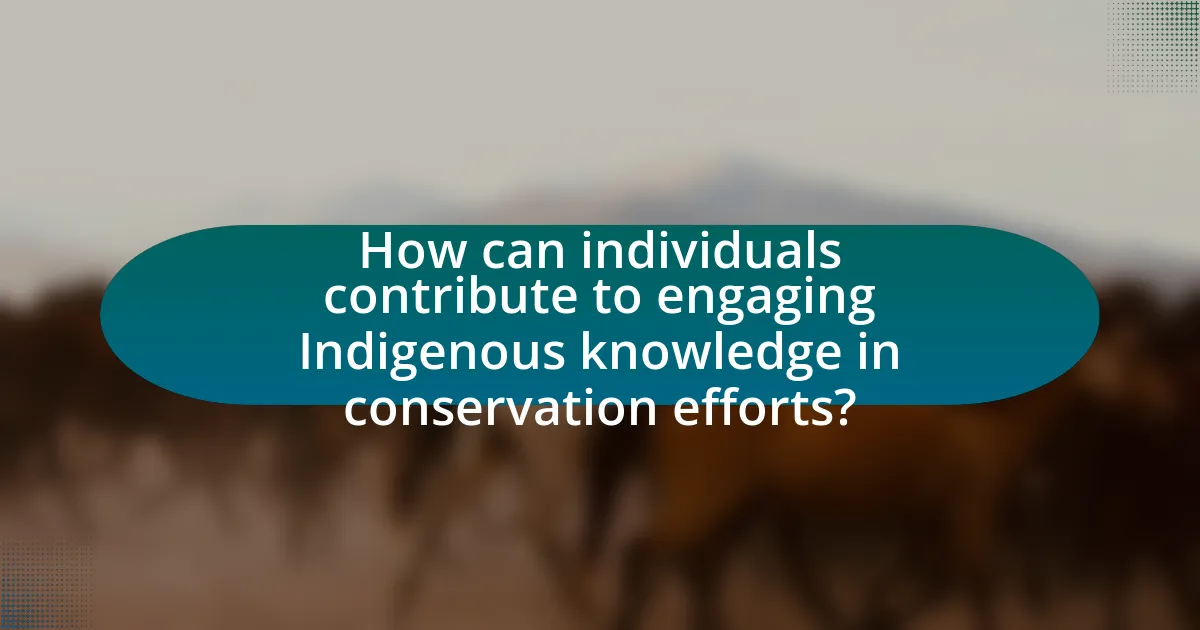
How can individuals contribute to engaging Indigenous knowledge in conservation efforts?
Individuals can contribute to engaging Indigenous knowledge in conservation efforts by actively collaborating with Indigenous communities and respecting their traditional ecological knowledge. This collaboration can involve participating in community-led conservation projects, supporting Indigenous land management practices, and advocating for the inclusion of Indigenous voices in policy-making. Research indicates that Indigenous land management practices, such as controlled burns, have been effective in reducing wildfire risks and promoting biodiversity, demonstrating the value of integrating Indigenous knowledge into contemporary conservation strategies.
What actions can individuals take to support Indigenous-led conservation initiatives?
Individuals can support Indigenous-led conservation initiatives by actively participating in and promoting Indigenous rights and land stewardship practices. Engaging with Indigenous communities to understand their conservation methods and respecting their traditional ecological knowledge is crucial. For instance, individuals can advocate for policies that recognize Indigenous land rights, as studies show that Indigenous-managed lands often have higher biodiversity and better conservation outcomes. Additionally, supporting Indigenous-led organizations through donations or volunteer work can amplify their efforts and provide necessary resources for conservation projects.
How can individuals advocate for the recognition of Indigenous knowledge in environmental policies?
Individuals can advocate for the recognition of Indigenous knowledge in environmental policies by actively engaging with Indigenous communities and supporting their rights to land and resources. This engagement can include participating in public forums, promoting Indigenous-led initiatives, and collaborating on research that incorporates traditional ecological knowledge. Evidence shows that integrating Indigenous knowledge into environmental management leads to more effective conservation outcomes, as demonstrated by studies like the one published in the journal “Nature” which highlights the success of Indigenous stewardship in biodiversity preservation. By amplifying Indigenous voices and ensuring their knowledge is respected in policy-making, individuals can contribute to more holistic and sustainable environmental practices.
What are some best practices for engaging with Indigenous communities respectfully?
To engage with Indigenous communities respectfully, prioritize building genuine relationships based on trust and mutual respect. This involves actively listening to community members, acknowledging their rights and knowledge systems, and involving them in decision-making processes that affect their lands and resources. Research indicates that successful collaborations often stem from recognizing Indigenous sovereignty and integrating traditional ecological knowledge into conservation efforts, as highlighted in the report “Indigenous Knowledge in Conservation” by the United Nations Environment Programme.

